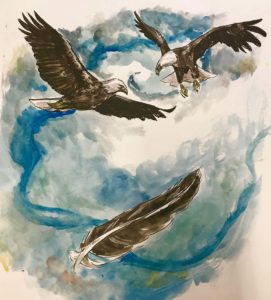
I can’t get to my binoculars quickly enough. The dark shape soars above us in effortless circles. I can see the flash of white tail feathers in the sun. I fumble with the protective covers of my binoculars and finally squint through the eyepieces as my kayak twists sideways in the water. The bald eagle flying overhead is so high up that the enormous raptor appears no larger than a wren. Just as I’m about to look away, another appears seemingly from nowhere. They call out to one another in their chittering songs as they circle ever higher. I want to watch them longer but I’ll need to paddle hard to catch up with the rest of the group. The excitement still gets me every time even though this must be the fifth or sixth eagle to grace our presence on the Lower Flathead River.
To me, the bald eagle embodies the majesty and joy I feel seeing the beautiful surrounding landscapes of Montana. They inspire me so much that I’ve painted them multiple times in my journal. However, these great birds are better known as the U.S. national symbol. It’s something that I find ironic—these great birds were nearly hunted to extinction because they were considered ‘vermin’ and I witnessed the bald eagle, a symbol of freedom, while in the middle of the Flathead Reservation. It made me wonder instead what the bald eagle means to those that have lived and managed this land the longest—the Confederated Salish and Kootenai Tribes.
The Lower Flathead River and surrounding buffer zone around it is managed by the Confederated Salish and Kootenai Tribes on the Flathead Reservation. Here, non-tribal members can recreate on the river and camp so long as they have a permit. We were careful to leave as little impact on the land as possible. As we traveled by water, we were able to see the abundant wildlife on the Flathead. Along with deer, jumping fish, red-tailed hawk, osprey, bald eagles, golden eagles, and even a pair of otters, we saw lots of cattle. Because of the Flathead Allotment Act of 1904, a lot of the reservation land was sold off to non-tribal members known as homesteaders. The cattle belong to the homesteaders as well as Native ranchers. Riparian ecosystems are fragile and the cattle’s heavy usage of the water had me wondering about conservation in agricultural practices and how the Confederated Salish and Kootenai tribes were working with cattle ranchers in the Lower Flathead River Corridor.
To learn more about the Reservation and its management before going out into the river, we met with a tribal member named Lester Bigcrane. He has worked in the Natural Resource Department for over 30 years and is the manager of the CSKT Wildlands Recreation. We sat with him in a private conference room and he brought us each a map of the Lower Flathead River. He spoke about how important the health of the land is for future generations and cultural heritage. However, he expressed concerns over issues such as overgrazing and abuses of the land by people. What I found most interesting was how he talked about our responsibility to the land. Lester said that he taught kids about how to respect places such as the Flathead River by following the traditional values and rules to protect it, but it is up to them to be responsible by making the right choices.
Throughout this entire course and into this last section we discussed Traditional Ecological Knowledge and principles that we could integrate into our own non-tribal worldviews without appropriating culture or knowledge from First Nations and Native American people. This encompasses what we call the three R’s: reciprocity, respect, and responsibility. I was reminded of these concepts when a member of our group, Kasei, found an eagle feather on the ground among the rocks along the shore of the Flathead River. She pointed it out to me and I was the first to touch it. I made sure to leave it there in a special place as a thank you to the river. As I said farewell to the feather, I wondered in what ways I can take what I’ve learned in the course to make the bald eagle more fitting as a national symbol.
2 Replies to “River of Eagles by Rainey Strippelhoff”
Comments are closed.
Beautiful, so proud of you, you aspire to fleeting heights, I am in awe of your potential future !!!!! Wishing you well, granddaughter !!!!!!!
Excellent essay, Rainey! Five stars for sure! And the artwork is beautiful! I can’t wait to see what you do next! I love you and wish you all the best for the new school year at Humboldt! Blessings from Mamaw.